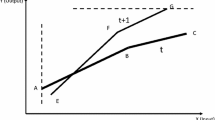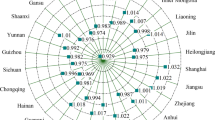Abstract
The metafrontier Malmquist–Luenberger (MML) index was used to measure the environmentally sensitive productivity and analyze its decompositions on China’s regional productivity growth. Using the MML index, the environmental undesirable outputs and regional heterogeneities were analyzed simultaneously. The empirical results showed that although China had accomplished rapid growth rate of GDP over the last decade, environmentally sensitive productivity has been relatively constant with a low growth rate. The productivity growth is driven mainly by technology innovation. Regarding the regional differences, the eastern area showed the highest productivity growth, whereas the central and western areas showed productivity deterioration. Some implications and suggestions on the regional differences are proposed based on the empirical results.









Similar content being viewed by others
Notes
RMB is the official currency of China.
References
Battese GE, Rao DSP (2002) Technology gap, efficiency, and a stochastic metafrontier function. Int J Bus Econ 1:87–93
Battese GE, Rao DSP, O’Donnell CJ (2004) A metafrontier production function for estimation of technical efficiencies and technology gaps for firms operating under different technologies. J Prod Anal 21:91–103
Bian Y, Yang F (2010) Resource and environment efficiency analysis of provinces in China: a DEA approach based on Shannon’s entropy. Energy Policy 38:1909–1917
BP (2011) Statistical review of world energy. http://www.bp.com/statisticalreview
Chang TP, Hu JL (2010) Total-factor energy productivity growth, technical progress, and efficiency change: an empirical study of China. Appl Energy 87:3262–3270
Choi Y, Lee EY (2009) Optimizing risk management for the sustainable performance of the regional innovation system in Korea through meta-mediation. Hum Ecol Risk Assess 15:270–280
Choi Y, Lee EY, Wu DD (2010) The risk-effective sustainability of policies: the small business credit environment in Korea. Int J of Environ. and Pollut 42:317–329
Choi Y, Zhang N, Zhou P (2012) Efficiency and abatement costs of energy-related \({\rm CO}_2\) emissions in China: a slacks-based efficiency measure. Appl Energy 98:198–208
Chung YH, Färe R, Grosskopf S (1997) Productivity and undesirable outputs: a directional distance function approach. J Environ Manag 51:229–240
Färe R, Grosskopf S, Norris M, Zhang Z (1994) Productivity growth, technical progress, and efficiency change in industrialized countries. Am Econ Rev 84:66–83
Färe R, Grosskopf S, Pasurka CA Jr (2001) Accounting for air pollution emissions in measures of state manufacturing productivity growth. J Reg Sci 41:381–409
Guo X, Zhu L, Fan Y, Xie B (2011) Evaluation of potential reductions in carbon emissions in Chinese provinces based on environmental DEA. Energy Policy 39:2352–2360
Hu JL (2006) Efficient air pollution abatement for regions in China. Int J Sustain Dev World Ecol 13:327–340
Hu JL, Wang SC (2006) Total-factor energy efficiency of regions in China. Energy Policy 34:3206–3217
IPCC (2006) IPCC guidelines for National Greenhouse Gas Inventories. http://www.ipcc-nggip.iges.or.jp/public/2006gl/vol2.html
Jeon BM, Sickles RC (2004) The role of environmental factors in growth accounting. J Appl Econ 19:567–591
Krugman P (1994) The myth of Asia’s miracle. Foreign Aff 73:62–78
Kumar S (2006) Environmentally sensitive productivity growth: a global analysis using Malmquist–Luenberger index. Ecol Econ 56:280–293
Li LB, Hu JL (2012) Ecological total-factor energy efficiency of regions in China. Energy Policy 46:216–224
Lindmark M (2004) Patterns of historical \({{\rm CO}_2}\) intensity transitions among high and low-income countries. Explor Econ Hist 41:426–447
Nakano M, Managi S (2008) Regulatory reforms and productivity: an empirical analysis of the Japanese electricity industry. Energy Policy 36:201–209
National Bureau of Statistics of China (NBSC) (2005) China Statistical Year book 2010. China Statistics Press, Beijing
National Bureau of Statistics of China (NBSC) (2011) China Statistical Year book 2010. China Statistics Press, Beijing
National Bureau of Statistics of China (NBSC) (2002–2010a) China Statistical Year book 2010, China Statistics Press, Beijing
National Bureau of Statistics of China (NBSC) (2002–2010b) China Energy Statistical Year book, China Statistics Press, Beijing
National Development and Reform Commission (NDRC) (2007) National Greenhouse Gas Inventory of the People’s Republic of China (in Chinese). Chinese Environmental Science Press, Beijing
Oh DH (2010) A metafrontier approach for measuring an environmentally sensitive productivity growth index. Energy Econ 32:146–157
Oh DH, Lee JD (2010) A metafrontier approach for measuring Malmquist Productivity Index. Empirical Econ 32:46–64
Shi GM, Bi J, Wang J (2010) Chinese regional industrial energy efficiency evaluation based on a DEA model of fixing non-energy inputs. Energy Policy 38:6172–6179
Tulkens H, Vanden Eeckaut P (1995) Non-parametric efficiency, progress and regress measures for panel data: methodological aspects. Eur J Oper Res 80:474–499
Weber W, Domazlicky B (2001) Productivity growth and pollution in state manufacturing. Rev Econ Stat 83:195–199
Wei YM, Liao H, Fan Y (2007) An empirical analysis of energy efficiency in China’s iron and steel sector. Energy 32:2262–2270
Wu Y (2009) China’s capital stock series by region and sector. The University of Western Australia Discussion Paper 09.02
Wu Y (2010) Regional environmental performance and its determinants in China. China World Econ 18:73–89
Yeh T, Chen T, Lai P (2010) A comparative study of energy utilization efficiency between Taiwan and China. Energy Policy 38:2386–2394
Yörük BK, Zaim O (2005) Productivity growth in OECD countries: a comparison with Malmquist indices. J Comp Econ 33:401–420
Yu MM, Hsu SH, Chang CC, Lee DH (2008) Productivity growth of Taiwan’s major domestic airports in the presence of aircraft noise. Transp Res E 44:543–554
Zhang C, Liu H, Bressers H, Buchanan K (2011) Productivity growth and environmental regulations—accounting for undesirable outputs: analysis of China’s thirty provincial regions using the Malmquist-Luenberger index. Ecol Econ 70:2369–2379
Zhang N, Choi Y (2013a) Total-factor carbon emission performance of fossil fuel power plants in China: a metafrontier non-radial Malmquist index analysis. Energy Econ 40:549–559
Zhang N, Choi Y (2013b) A comparative study of dynamic changes in \({\rm CO}_2\) emission performance of fossil fuel power plants in China and Korea. Energy Policy 62:324–332
Zhou P, Ang BW (2008) Linear programming models for measuring economy-wide energy efficiency performance. Energy Policy 36:2911–2916
Zhou P, Ang BW, Zhou DQ (2012) Measuring economy-wide energy efficiency performance: a parametric frontier approach. Appl Energy 90:196–200
Acknowledgments
This research was jointly supported by the Basic Science Research Program through the National Research Foundation (NRF) of Korea funded by the Ministry of Science, ICT, and Future Planning (NRF-2012R1A1A1013071); Inha University; National Science foundation of China (41461118); China Postdoctoral Foundation (2014M551849); and Humanities and Social Science Fund of Jiangxi (JJ1420).
Author information
Authors and Affiliations
Corresponding author
Appendix: Estimating the trade-off factor
Appendix: Estimating the trade-off factor
The trade-off factor is the slope of the environmental Kuznets curve (EKC). The estimation model is as follows:
where per\(\hbox {CO}_{2}\) is per capita \(\hbox {CO}_{2}\) emission (unit: kg \(\hbox {CO}_{2}\) per person); perGDP is per capita GDP (unit: RMB per person); \(i\) and \(t\) represent region and time, respectively. Since our sample is balanced panel data, the first step to estimation is to select a suitable estimation model for panel data regression. The Hausman test result signifies that the fixed effects model is superior to the random effects model (test statistics 218.9, degrees of freedom 2, critical value at the 1 % significance level 9.21). The fixed effects model estimation result is listed in Table 10, where the within estimator is used in estimating the fixed effects model.
The estimated parameter \({\hat{\beta }}_1\) and \({\hat{\beta }}_2\) is used for calculating trade-off factor of region \(i\) at time \(t\), \(\beta _{it}\), as follows:
Since \(\mathrm{perGDP}_{it}\) in Eq. (11) is different across region and over time, the trade-off factor varies across region and over time.
Rights and permissions
About this article
Cite this article
Choi, Y., Oh, Dh. & Zhang, N. Environmentally sensitive productivity growth and its decompositions in China: a metafrontier Malmquist–Luenberger productivity index approach. Empir Econ 49, 1017–1043 (2015). https://doi.org/10.1007/s00181-014-0896-5
Received:
Accepted:
Published:
Issue Date:
DOI: https://doi.org/10.1007/s00181-014-0896-5




